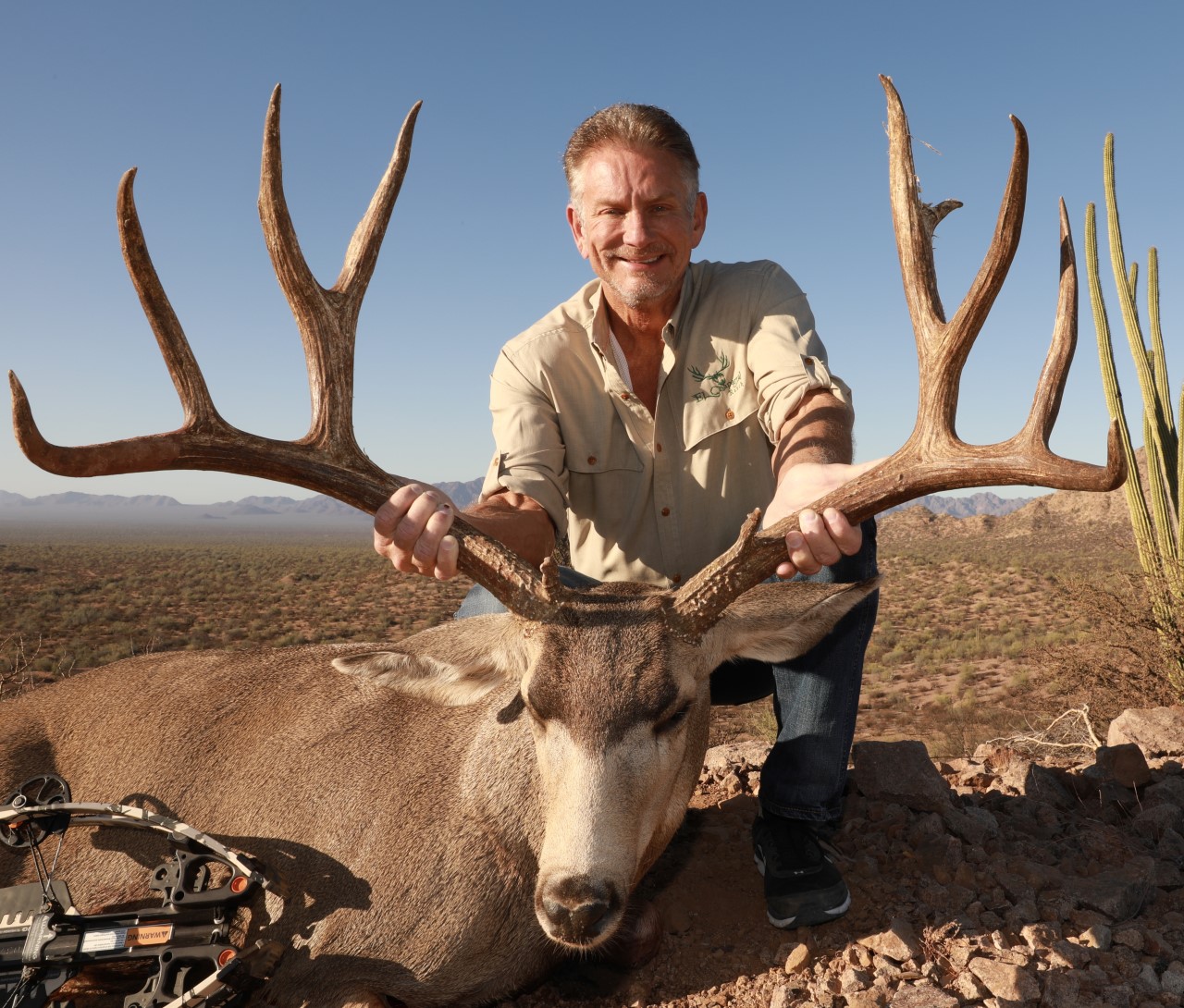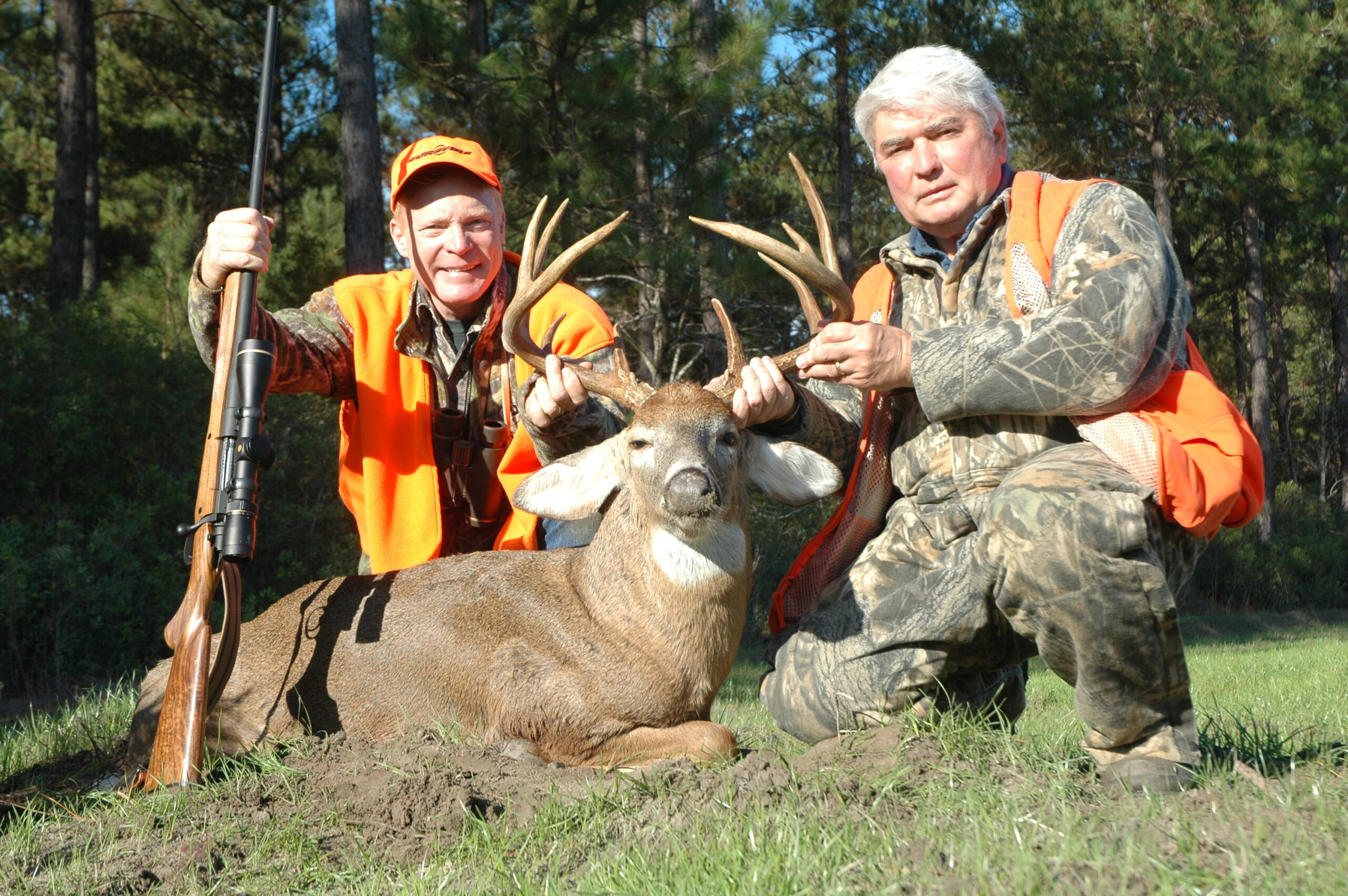 The lioness was crouched and switching her tail. “Grab your rifle.  We obviously don’t want to shoot her, but we don’t want her in the Land Cruiser with us either!” exclaimed Hassanali, my PH. It’s the first hour of the first day of a 21-day Tanzania safari, and I am in a stare down with the first lion I have ever seen in the wild. I feel the adrenaline coursing through my veins as I try to look past the female to the male that accompanied her, heading into the bush.
The lioness was crouched and switching her tail. “Grab your rifle.  We obviously don’t want to shoot her, but we don’t want her in the Land Cruiser with us either!” exclaimed Hassanali, my PH. It’s the first hour of the first day of a 21-day Tanzania safari, and I am in a stare down with the first lion I have ever seen in the wild. I feel the adrenaline coursing through my veins as I try to look past the female to the male that accompanied her, heading into the bush.
Hilary “Big Cat” Daffi and Hassanali “Lion King” Ladak live up to their reputations of producing Panthera leo.  I had booked this hunt on the strong recommendations of two good friends and SCI Members, Gary Christensen and Nick White, with whom I am privileged to serve on our Central Washington SCI Chapter’s Board of Directors.  I met Hilary the previous year at the SCI Convention and was convinced this was the outfit with which I wanted to hunt dangerous game.  Hilary’s Lunda concession is situated adjacent to Ruaha National Park in close proximity to the village of Tungamarenga in Tanzania’s central highlands.  The area’s topography is generally level interspersed with forested hillsides. Vegetation is a mix of savannah and miombo woodlands with the occasional baobab tree.  
This safari was action-packed from the first day as a big, beautiful leopard was on the bait that first afternoon. I really don’t want to talk about the leopard. Suffice to say I missed and to that end I am in good company.  Obviously I now have a good reason to return and try again.
 The third day produced a great lion on a chance encounter, and the seventh day, following an exciting stalk, I took a magnificent elephant with 52-pound tusks, each measuring 183 centimeters (6 feet).
The third day produced a great lion on a chance encounter, and the seventh day, following an exciting stalk, I took a magnificent elephant with 52-pound tusks, each measuring 183 centimeters (6 feet).
The daily routine quickly settled in, starting with coffee prepared by Joel, the camp manager. Joel is one of the most delightful people I have met, and made sure that all my camp needs were not only met but also exceeded. Every meal was superb. Bushiri Saidi, the head chef, did wonders, preparing five-star meals over wood fire and hot coals.
Elephants are abundant in the concession, and early on we sighted three likely candidates. The second day and the morning of day three found us on tracks, trying to get on to the big bulls. Big trophies grow old by being really smart, and these big boys were no exception.  The bulls went into the bush early in the morning, making stalking a real challenge. Adding to the challenge was swirling wind and the elephant’s phenomenal sense of smell and hearing. We were busted several times, and each stalk became more exciting then the previous.
After lunch on the third day, we were driving along, winded a kill, and verified lions had taken a zebra.  Dismounting, we observed two lions asleep in the shade across the korongo (gully).  Hassanali advised that both were legal, with one slightly larger and having a bit more mane. I have learned that “the big ones look big,” and it is best to take a hunting opportunity when it presents itself rather than “hold out” for a bigger trophy.   After a short and careful stalk, I took aim with my custom .416 Remington Magnum and sent my hand-loaded 400-grain Swift A-Frame bullet on its way.  The bullet slammed into the lion’s shoulder, resulting in a quick, clean kill.  The big guy never woke up!
 The next four days we scouted for Cape buffalo, elephant and sable, often dismounting and following a track.  Hassanali has a great sense of humor with impeccable timing.  While tracking Cape buffalo through very thick bush with little visibility, Hassanali turned to me and said, “Be ready, as in this bush it doesn’t matter where you are in line. The buff can come from anywhere.”  That was in response to an earlier conversation about an encounter with a black mamba where I commented that in such situations, I was glad to be the last in line.
The next four days we scouted for Cape buffalo, elephant and sable, often dismounting and following a track.  Hassanali has a great sense of humor with impeccable timing.  While tracking Cape buffalo through very thick bush with little visibility, Hassanali turned to me and said, “Be ready, as in this bush it doesn’t matter where you are in line. The buff can come from anywhere.”  That was in response to an earlier conversation about an encounter with a black mamba where I commented that in such situations, I was glad to be the last in line.
Day seven, we started a bit earlier in the morning, hoping to catch the elephants out in the open grasslands before they hit the bush.  As we neared one spot, Andrew, our tracker, spotted the huge bull that had eluded us twice already. Dismounting, we made our way to cover and worked toward an opening in the bush where the elephants were heading, but one of the big boy’s sentinels winded us and the elephants were off. Andrew, taking point, took off running and was urging me to follow quickly.  We ran for about half a mile, coming to another opening where Andrew set up the sticks in some cover just before the elephants emerged.  Winding us again, a sentinel turned to us, simultaneously uncovering the big bull.  I let loose from a distance of 20 feet, taking a side brain shot and dropping the magnificent animal in his tracks.  Upon taking this incredible elephant, I was deeply humbled, and simultaneously jubilant. 
 Villagers crave protein and elephants provide a great deal of meat.¬† The elephant was on his badly worn last set of teeth–a clear sign this magnificent creature did not have a great deal of time remaining.¬† Thus, this hunter has his trophy, memories, and knowledge that his elephant will feed many people for a long time.
Villagers crave protein and elephants provide a great deal of meat.¬† The elephant was on his badly worn last set of teeth–a clear sign this magnificent creature did not have a great deal of time remaining.¬† Thus, this hunter has his trophy, memories, and knowledge that his elephant will feed many people for a long time.
That safari was truly a trip of a lifetime and every bit the adventure I read about since I was young.  A hunter and his team, however skillful, are occasionally augmented by good fortune. I couldn’t help but think that both my parents were looking down from above and shared responsibility for that awesome experience.
The term “safari” means “long journey” in Swahili. My long journey was not only the adventure of the hunt, but also an adventure of Tanzania’s National Parks, its people, customs and culture. Seven days into a 21-day safari and my hunting was complete, but it was time to continue the long journey.РTim Vining




